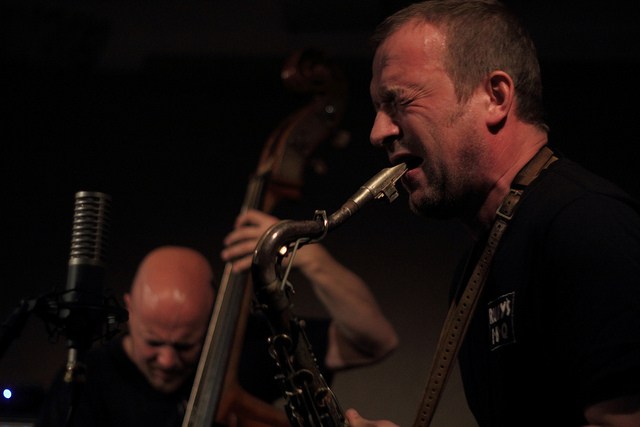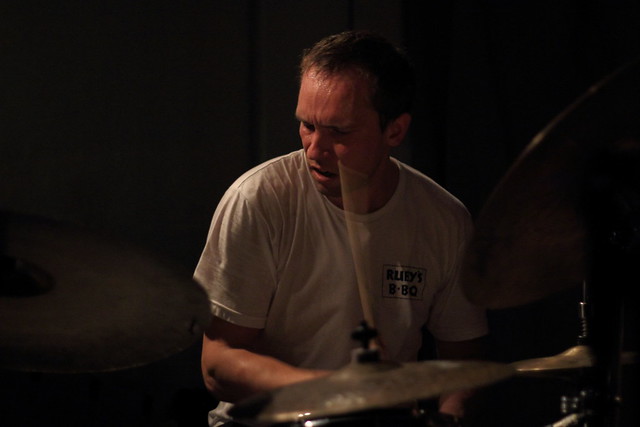
As if the release of a new album by the esteemed Norwegian trumpeter, Supersilent member, and David Sylvian (to name one of many) collaborator Arve Henriksen didn’t have enough heft, Rune Grammofon have managed to create the weightiest of packages for it. Solidification is a beautiful, and very heavy, seven LP box set, which positions that new album, entitled Chron, alongside double LP sets of each of Henriksen’s three previous Rune Grammofon LPs, each with bonus tracks, along with high quality audio DVDs and a booklet. Anyone would think they were trying to make some sort of point.
Not just a point about how important they feel this music is (which they clearly do): the very title Solidification makes me think a bit more widely than the quality of the music, but instead of a gradual process, tectonic plates perhaps, about how all that has gone before has somehow led to this moment. It invites the listener to follow Arve on a journey, both temporal and geographical, to try to make sense of this particular catalogue (one which for these purposes excludes the 2008 ECM release Cartography), as a cohesive body of work.
That journey begins in Japan, in 2001, with the evocative Sakuteiki release. The album opens with Henriksen’s signature trumpet sound: soft, breathy, unprocessed smears of sound, owing something to Jon Hassell. The album and track titles disclose the fact that Henriksen is setting out to paint images of Japan, from temples to cherry blossom-laden trees, from tea houses to bamboo. He succeeds, partly by virtue of that trumpet sound, which resembles at times a shakuhachi, and elsewhere a hushed voice in prayer.
The more still and spacious compositions seem to draw from gagaku, that slow-paced and elegant Japanese court music, but elsewhere tracks edge out carefully into different, more experimental terrain. “White Gravel” is a beautiful recording of something – quite possibly gravel, quite possibly white in colour – being dropped onto a hard surface (for all its brevity, the crisp sounds in the piece reminded me of Francois Bayle’s INA-GRM piece Erosphere), while “Bonsai Ritual” has Arve banging delicately on a bit of metal. The huge, deep pedal point trumpet drones in bonus track “Samyaku” cast long dark shadows, and serve as an omen for what we’ll hear in future records, but the long overdue return to the places delineated in Sakuteiki is one of the bright spots in this collection.
2004’s Chiaroscuro feels much more escapist than Sakuteiki, as if Henriksen was seeking to depict a fantasy world, rather than anchoring his work in reality (I’m not sure how much I should read into the fact that the booklet mentions some unspecified trauma in his personal life at the time). You don’t get the sense of any particular place here, track titles give no clues, instruments such as hand drums appear, playing vaguely tribal if unrecognisable rhythms – and this, with the addition of some ambient electronics makes this feel like the closest satellite of Hassell’s Fourth World. But despite the lack of specific geographical fix, this still feels like a landscape, the electronics of Jan Bang and Erik Honore sketching out a a calm, breezy snowscape as viewed from above, with Arve’s trumpet lifting us up to that vantage point like a bird rising on thermals.
Despite this height, Chiaroscuro still manages to knock its knees on the coffee table at times. But there is much to appreciate here, in particular Henriksen’s debuting of his incredible singing voice on the record. When the whispering trumpet drops out of “Opening Image”, it is replaced, imperceptibly at first, by a soft voice, which from nowhere soars like that of a female soprano – I can still remember searching the credits the first time I heard this to work out who she was. Elsewhere, black shapes reappear to disrupt the ambience, with a couple of noir moments interrupting the snow-white flight: the static, vinyl crackle and drowned strings of “Scuro” bring to mind the output of Erik Skodvin’s Miasmah label.
After the airy detachment of Chiaroscuro, Arve’s decision to ground his 2007 release in his home town Strjon was perhaps to be welcomed. Track titles reference the surrounding landscape, and parallel those on Sakuteiki: for “White Gravel” we have “Leaf and Rock”, for “Shrine” we have “Ancient and Accepted Rite”, for “Paths Around The Pond” we have “Green Lake”. But, specific location aside, there is a key difference from Sakuteiki, which is apparent from the outset, in that that prior commitment to no processing, no effects, appears to be gone. And in doing so, perversely, Henriksen somehow manages to make more of an emotional connection than on previous releases, as if any too-smooth-to-feel surfaces have been sanded down, rendered more tactile and a little bit raw.
Much of this can be attributed to a change in collaborators: instead of Bang and Honore, Henriksen drafted in his Supersilent colleagues Helge Sten and Ståle Storløkken, not a twosome known for too much niceness. And so the keyboards in second track “Black Mountain” have darkness and dirt ground into them, while the pretty face of “Ascent” is cut into with some rough electronics. These aren’t the parts of town that tourists get to see. The tasteful quasi-tribal rhythms of Chiaroscuro are replaced by some angular prepared piano patterns, while Henriksen’s experimental sound collection extends to includes a muffled metallic clanging, like a ski lift swaying in off season. But it is the concluding black run from the title track to “Glacier Descent” which is probably the outstanding performance of Henriksen’s solo career so far; his voice weaving wordlessly over deep layers of trumpet, electronic and throat-singing drone.
And so to the new album, Chron. If the title of album and box set lead you to think that this might something of a chronological retrospective exercise, you’d be surprised by the fact that Chron appears to look forward more than it does back. There is a noticeable lack of trumpet and singing voice in this; instead, it is the colours from around the perimeter of his previous pallete which he is playing with on Chron, resulting in his most experimental album to date. While this can result in awe-inspiring wall to ceiling drones, as on the title track, and in tangled splashes of rhythmic concrète, as on the impressive opening piece “Proto-Earth”, elsewhere they feel frustratingly incomplete, like mere sketches for possible future works.
Chron’s liner notes reveal that it was recorded across a number of sessions – and in a number of geographical locations. Perhaps even more so than the intrinsic quality of the pieces themselves, it is that lack of connection, to time and to place (real or imaginary), that makes this feel fragmented. While I was expecting some sort of Solidification, the constituent parts of Chron feel like separate islands, rather than a contiguous piece of land. The direction of travel is very intriguing though, and with a bit more momentum, what comes next may yet be seismic.







































































